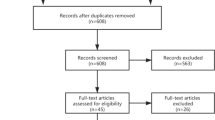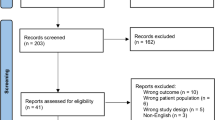Abstract
Purpose
Blood loss can be substantial and will influence morbidity and mortality after total knee arthroplasty. This study evaluated whether patient-specific instruments (PSI) can reduce blood loss because the intramedullary canal is not opened during the procedure and whether hidden blood loss can be reduced by its use.
Methods
Seventy-five patients operated with the Signature PSI technique were compared with a matched group operated with conventional instruments. Maximal drop in haemoglobin (Hb) and hematocrit (HTC) level were compared at day 2 and day 4. Transfusions were noted. Clinical outcomes like range of motion and knee society scores were studied as secondary outcomes.
Results
No statistically significant difference for calculated blood loss, maximal drop in Hb or HTC and transfusions were found. No clinical differences in range of motion or knee society scores were observed.
Conclusions
The use of PSI-assisted total knee arthroplasty (TKA) did not result in less blood loss compared with conventional minimally invasive TKA with tourniquet. No reduction in hidden blood loss was observed either. According to this study, the argument of reduced transfusion cost should not be used in cost-effectiveness calculations of PSI-assisted TKA.
Level of evidence
III.
Similar content being viewed by others
References
Ajwani SH, Jones M, Jarrat JW, Shepard GJ, Ryan WG (2012) Computer assisted versus conventional total knee replacement: a comparison of tourniquet time, blood loss and length of stay. Knee 19:606–610
Alshryda S, Sarda P, Sukeik M, Nargol A, Blenkinsopp J, Mason JM (2011) Tranexamic acid in total knee replacement: a systematic review and meta-analysis. J Bone Jt Surg Br 93:1577–1585
Baldini A, Adravanti P (2008) Less invasive TKA: extramedullary femoral reference without navigation. Clin Orthop Relat Res 466:2694–2700
Bali K, Walker P, Bruce W (2012) Custom-fit total knee arthroplasty: our initial experience in 32 knees. J Arthroplast 27:1149–1154
Bao N, Zhou L, Cong Y, Guo T, Fan W, Chang Z, Zhao J (2013) Free fatty acids are responsible for the hidden blood loss in total hip and knee arthroplasty. Med Hypotheses 81:104–107
Brunson ME, Alexander JW (1990) Mechanisms of transfusion-induced immunosuppression. Transfusion 30:651–658
Conteduca F, Massai F, Ioro R, Zanzotto E, Luzon D, Ferretti A (2009) Blood loss in computer-assisted mobile bearing total knee arthroplasty. A comparison of computer-assisted surgery with a conventional technique. Int Orthop 33:1609–1613
Cushner FD, Friedman RJ (1991) Blood loss in total knee arthroplasty. Clin Orthop Relat Res 269:98–101
Diamond PT, Conaway MR, Mody SH, Bhirangi K (2006) Influence of hemoglobin levels on inpatient rehabilitation outcomes after total knee arthroplasty. J Arthroplast 21:636–641
Good L, Peterson E, Lisander B (2003) Tranexamic acid decreases external blood loss but not hidden blood loss in total knee replacement. Br J Anaesth 90:596–599
Gross JB (1983) Estimating allowable blood loss: corrected for dilution. Anesthesiology 58:277–280
Heyse T, Haas SB, Drinkwater D, Lyman S, Kim HJ, Kahn BA, Figgie MP (2014) Intraarticular fibrinogen does not reduce blood loss in TKA: a randomized clinical trial. Clin Orthop Relat Res 472:272–276
Hinarejos P, Corrales M, Matamalas A, Bisbe E, Caceres E (2009) Computer-assisted surgery can reduce blood loss after total knee arthroplasty. Knee Surg Sports Traumatol Arthrosc 17:356–360
Kalairajah Y, Simpson D, Cossey AJ, Verrall GM, Spriggins AJ (2005) Blood loss after total knee replacement: effects of computer-assisted surgery. J Bone Jt Surg Br 87:1480–1482
Khanna A, Gougoulias N, Longo UG, Mafulli N (2009) Minimally invasive total knee arthroplasty: a systematic review. Orthop Clin N Am 40:479–489
Kim HJ, Fraser MR, Kahn B, Lyman S, Figgie MP (2012) The efficacy of a thrombin-based hemostatic agent in unilateral total knee arthroplasty: a randomized controlled trial. J Bone Jt Surg Am 94:1160–1165
Ko PS, Tio MK, Tang YK, Tsang WL, Lam JJ (2003) Sealing the intramedullary femoral canal with autologous bone plug in total knee arthroplasty. J Arthroplast 18:6–9
Kumar N, Saleh J, Gardiner E, Devadoss VG, Howell FR (2000) Plugging the intramedullary canal of the femur in total knee arthroplasty: reduction in postoperative blood loss. J Arthroplast 15:947–949
McConnell J, Dillon J, Kinninmonth A, Sarung M, Picard F (2012) Blood loss following total knee replacement is reduced when using computer-assisted versus standard methods. Acta Orthop Belg 78:75–79
Mohanial PK, Sandiford N, Skinner JA, Samsani S (2013) Comparison of blood loss between computer assisted and conventional total knee arthroplasty. Indian J Orthop 47:63–66
Nunley RM, Ellison BS, Ruh EL, Williams BM, Foreman K, Ford AD, Barrack RL (2012) Are patient-specific cutting blocks cost-effective for total knee. Clin Orthop Relat Res 470:889–894
Oremus K, Sostaric S, Trkulja V, Haspi M (2014) Influence of tranexamic acid on postoperative autologous blood retransfusion in primary total hip and knee arthroplasty: a randomized controlled trial. Transfusion 54:31–41
Pietsch M, Djahani O, Zweiger C, Plattner F, Radl R, Tschauner C, Hofmann S (2013) Custom-fit minimally invasive total knee arthroplasty: effect on blood loss and early clinical outcomes. Knee Surg Sports Traumatol Arthrosc 21:2234–2240
Plymale MF, Capogna BM, Lovy AJ, Adler ML, Hirsch DM, Kim SJ (2012) Unipolar vs bipolar hemostasis in total knee arthroplasty: a prospective randomized trial. J Arthroplast 27:1133–1137
Prasad N, Padmanabhan V, Mullaji A (2007) Blood loss in total knee arthroplasty: an analysis of risk factors. Int Orthop 31:39–44
Raut VV, Stone MH, Wroblewski BM (1993) Reduction of postoperative blood loss after press-fit condylar knee arthroplasty with use of a femoral intramedullary plug. J Bone Joint Surg Am 75:1356–1357
Sehat KR, Evans RL, Newman JH (2004) Hidden blood loss following hip and knee arthroplasty. Correct management of blood loss should take hidden loss into account. J Bone Jt Surg Br 86:561–565
Sehat KR, Evans R, Newman JH (2000) How much blood is really lost in total knee arthroplasty? Correct blood loss management should take hidden loss into account. Knee 7:151–155
Stahl DL, Groeben H, Kroepfl D, Gautam S, Eikermann M (2012) Development and validation of a novel tool to estimate peri-operative blood loss. Anaesthesia 67:479–486
Stronach BM, Pelt CE, Erickson J, Peters CL (2013) Patient-specific total knee arthroplasty required frequent surgeon-directed changes. Clin Orthop Relat Res 471:169–174
Tai TW, Chang CW, Lai KA, Lin CJ, Yang CY (2012) Effects of tourniquet use on blood loss and soft-tissue damage in total knee arthroplasty: a randomized controlled trial. J Bone Jt Surg Am 94:2209–2215
Thiengwittayaporn S, Junsee D, Tanavalee A (2009) A comparison of blood loss in minimally invasive surgery with and without electromagnetic computer navigation in total knee arthroplasty. J Med Assoc Thai 92:S27–S32
Vundelinckx BJ, Bruckers L, De Mulder K, De Schepper J, Van Esbroeck G (2013) Functional and radiographic short-term outcome evaluation of the Visionaire system, a patient-matched instrumentation system for total knee arthroplasty. J Arthroplast 28:964–970
Watts CD, Pagnano MW (2012) Minimising blood loss and transfusion in contemporary hip and knee arthroplasty. J Bone Jt Surg Br 94(Suppl):8–10
Wind TC, Barfield WR, Moskal JT (2013) The effect of tranexamic acid on blood loss and transfusion rate in primary total knee arthroplasty. J Arthroplast 28:1080–1083
Yang ZG, Chen WP, Wu LD (2012) Effectiveness and safety of tranexamic acid in reducing blood loss in total knee arthroplasty: a meta-analysis. J Bone Jt Surg Am 94:1153–1159
Author information
Authors and Affiliations
Corresponding author
Rights and permissions
About this article
Cite this article
Thienpont, E., Grosu, I., Paternostre, F. et al. The use of patient-specific instruments does not reduce blood loss during minimally invasive total knee arthroplasty?. Knee Surg Sports Traumatol Arthrosc 23, 2055–2060 (2015). https://doi.org/10.1007/s00167-014-2952-2
Received:
Accepted:
Published:
Issue Date:
DOI: https://doi.org/10.1007/s00167-014-2952-2




